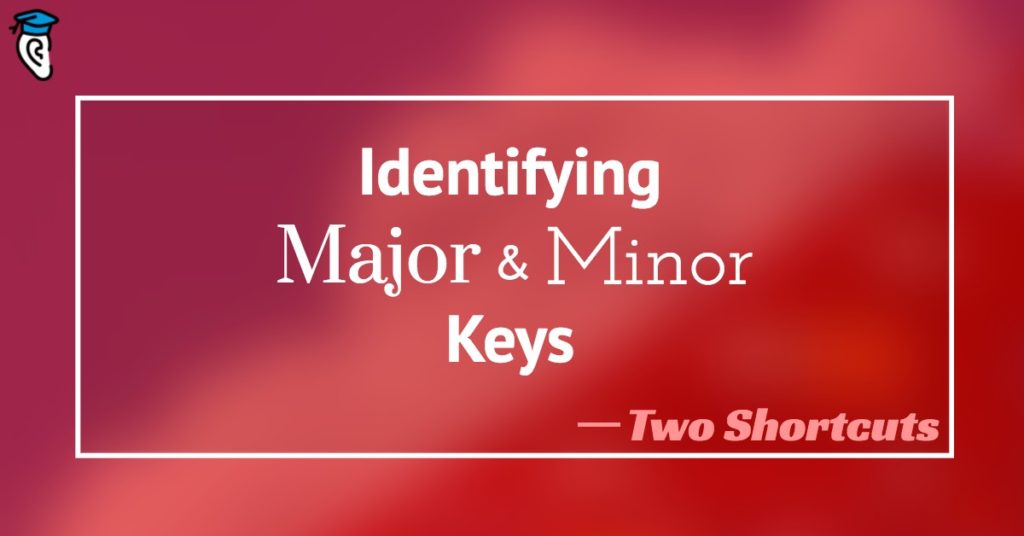Learning to identify major and minor keys is an essential skill for musicians. Once you know the key of a song you’re free to play it by ear or improvise over it. Keys come in two “flavors”, major and minor and so it’s valuable to learn to identify major and minor keys by ear.
This is a summary post.
→ Read the full guide
Knowing The Key Sets You Free
Before you can play a song by ear or improvise over it, you’ll want to know its key. That’s because a song’s key reveals which notes fit in the song.
When you learn to find a song’s key by ear you become much more free to express your own musical ideas. That’s because instead of choosing the notes to play from the full set of all possible notes, you can choose notes which belong to the key.
By keeping to the notes of the key you ensure your chosen notes will sound musical. They may not always be the “right” notes, but they will fit in well enough with the song. That means if you’re improvising, your solo will always sound like you know what you’re doing, and if you’re trying to play by ear then you will be able to find the correct notes much quicker.
Finding a song’s key by ear seems difficult at first, but there are two shortcuts you can use. Before we cover those, let’s recap some fundamentals about musical key.
Major vs. Minor
Keys come in two “flavors”: Major and Minor.
Part of identifying the key of a song is finding the tonic note, e.g. “This song is in C”, or “It’s the key of A”. When people say this, they’re normally assuming the other part of identifying the key, which is: determining whether it’s Major or Minor.
Tip: Musicians normally assume a key is major unless stated otherwise because major keys are more commonly used. So in the two examples above, they probably meant “C Major” and “A Major”.
A song’s key is closely related to its scale:
- If the song’s in a major key, it will use a major scale for its melody and chords.
- If the song’s in a minor key, it will use a minor scale for its melody and chords.
We’re simplifying things slightly here to help you learn to find keys faster. There are some subtleties of keys and scales, but in most of the music you’ll likely encounter, the rules above should be reliable.
Key and Chords
To distinguish major from minor keys it helps if you can distinguish major from minor chords.
- Major chords use the first, third and fifth notes of a major scale.
- Minor chords use the same degrees but of a minor scale.
We will assume you can tell major chords from minor chords. If you can’t, don’t worry! Just check out this guide to chord ear training and learn that skill first.
This chord skill is a good starting point because it’s generally easier to tell major vs minor with a single simple chord, compared with the overall key of a piece of music, and you can build on that chord skill using the shortcuts below to quickly learn to identify major and minor keys by ear.
Now, let’s get into our key-finding shortcuts.
Two Key-Finding Shortcuts
There are two shortcuts you can use to identify the key of a song as major or minor. Without these shortcuts you have to take a “brute force” approach, meaning you simply try guessing each possible key. Tedious!
These shortcuts will save time by helping you know which keys are likely.
At first you’ll need to “think through” each shortcut but as you practice you’ll find that using these shortcuts will become quicker. Eventually you will be able to identify the key as major or minor directly – you will have learned the “instinct”.
Shortcut 1: Check the Harmony
Listen for whether the chords in the song are mostly major or mostly minor. This gives you a big clue to whether the key is major or minor.
The key’s major/minor quality will generally match the most common chord quality:
- If the song has a bright and happy feel using mostly major chords? It’s a major key.
- If the song has a dark and gloomy feel, using mostly minor chords? It’s a minor key.
Simple as that! It’s not 100% fool-proof, but it’s a pretty reliable indicator.
Shortcut 2: Check the Tonic Chord
Find where in the song the tonic chord occurs and check if it’s major or minor. The key will almost certainly match.
The tonic chord is the chord based on the tonic note, a.k.a. the “root note” of the scale. For example: If the tonic chord is C Major? The key is C Major.
It’s a simple two-step process:
- First, find the tonic note. For help with this see this tutorial on major tonics and tutorial on minor tonics.
- When the song comes to rest on the tonic, is the current chord major or minor?
Identify Major and Minor Keys
Practice and experiment to master this skill of identifying major and minor keys by ear.
At first the process will be slow and methodical. Make the effort to develop the core skills you need. Practice distinguishing major from minor chords, and practice finding the tonic note and its chord.
Use the two shortcuts above to identify the key as major or minor. In time this will become so fast and easy as to feel like instinct. To learn more, see “How to Recognise Major and Minor Keys“.







